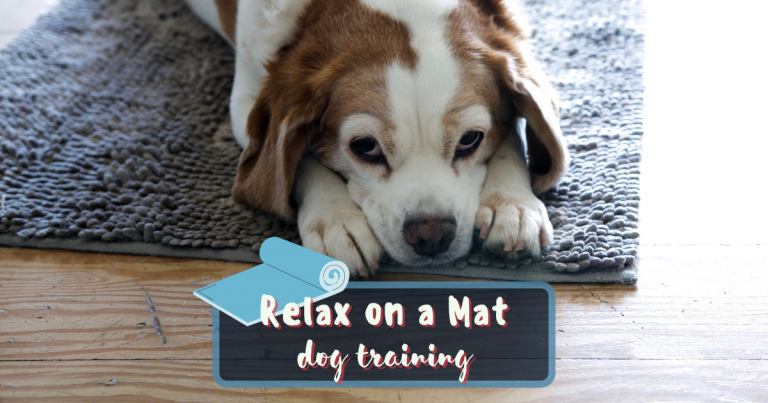Teaching your dog how to relax on a mat is an important part of their training. Honestly, if I had a brand new puppy now, this would be the first behavior I’d teach them.
This skill can help your dog stay calm in many environments. A calm and relaxed dog is much easier to manage and can be taught new commands more easily. When your dog knows how to relax on a mat, they will be able to stay calm in a variety of situations.
You will love the convenience of being able to take your dog anywhere and have them stay calm – at home, at the park, or even out on a walk. With this easy guide, you will be able to teach your dog this essential skill in no time at all.
Table of Contents
ToggleContents of this article:
- What is mat training for dogs?
- Equipment required for mat training.
- How to train your dog to relax on a mat.
- How do I get my dog to relax on a mat?
- Points to remember – mat training tips.
- Next steps of training your dog to relax on a mat.
- Other ways to support your mat training.
- Next steps of mat settle training – add your 3D’s.
- Adding the cue.
- Generalising the behavior to other articles.
- How do you train a puppy to use a mat?
- Summary.
What is mat training for dogs?
Dog mat training is a form of positive reinforcement training that rewards your dog for lying down on their mat and settling down. The mat becomes a special place for your dog that they associate with feeling calm.
With this training, we add value to the mat so it becomes a magnet for your dog – they will naturally want to go there to feel good.
Equipment required for mat training.
You will need a mat, a clicker or verbal marker, and some treats for training your dog to relax on a mat.
What type of mat is best for dog mat training?
I start with a sizeable piece of rubber-backed vet bed to train this behavior, because it’s comfy for the dog, can be easily moved around the house, it’s washable, doesn’t slip on hard floors, and it can be cut to smaller sizes.
Nearly any non-slip mat will do as a dog mat for mat training, as long as it’s big enough for your dog to lie down on comfortably and is easy to move around.
Make sure it won’t skid when your dog steps on it because we don’t want to spook them.
A bathmat works really well as a dog settle mat. A yoga mat is also good.
How to train your dog to relax on a mat.
We’re going to use shaping to train this behavior, which means we will be rewarding small, incremental steps towards the goal of the dog going to the mat and laying down.
We will not be asking for any behaviors during this training, as we don’t want to micromanage our dogs, but we will set up the environment so that your dog cannot fail and so they have lots of opportunities to get rewarded.
How do I get my dog to relax on a mat?
The first step in teaching your dog to relax on a mat is to create a positive association with the mat.
To train your dog to settle on a mat:
- Throw a piece of food away from you, where your dog can see it.
- When your dog goes to get the food, place the mat flat on the floor between you and your dog.
- After your dog has eaten the treat, they are likely to head back towards you. If they don’t, encourage them to come towards you by calling their name, giving a little whistle or making a kissy noise.
- On their way back to you, as soon as they place a paw on the mat, mark with a click of your clicker or use your marker word “Yes” or “Good” and reward them on the mat.
- If your dog puts more of their paws onto the mat, mark and reward.
- If they make any moves towards sitting or laying down, mark and reward, but try not to ask for these behaviours.
- If they lay down, give the dog a jackpot of multiple treats.
- Before your dog moves off the mat of their own volition, say a release cue (I use “Break”), and – making sure your dog sees it – throw a treat away from you to lure your dog off the mat.
- Go back to step 4 and when your dog steps on the mat mark and reward.
- Continue for 5 minutes.
- On your last rep, after giving your dog their release cue and luring them off the mat, take the mat off the floor and put it away.
Points to remember – mat training tips.
In between training sessions, put the mat away.
We don’t want the dog going onto the mat when we’re not paying attention and have them not getting rewarded for it. This devalues the mat and makes the training take a lot longer.
Make sure you’re not standing too close to the mat.
Stand a step or two away from the mat and gradually increase your distance from it, so that your dog is definitely targeting the mat and not you.
Don’t name it ’til you love it.
We will not give the behavior a cue until it looks the way we want it to – that is, the dog heads to the mat and lays down. Don’t be in a hurry to label the behavior, otherwise it can make it tricky to improve upon it.
Well done on taking your first steps towards mat training your dog.
Next steps of training your dog to relax on a mat.
Now that your dog is happily going to the mat, we need to hold out for them to lay down on it. This is where a lot of people go wrong in their mat training, because they get impatient and ask for too much too soon.
- If your dog is not yet laying down on the mat, do not ask them to sit or down. Just continue as you were, rewarding your dog for placing paws on the mat.
- Remember to reward your dog for any behaviors that are heading towards the goal of laying down on the mat, but do not attempt to ask them for these behaviors.
- Once your dog is reliably standing on the mat and not moving off it, you can begin to encourage them to lie down by using lure-and-capture techniques.
- Mark the behavior of standing on the mat, but deliver the reward in such a way that you’re luring them into a down position before you release the reward. Then give them more rewards in place.
- If they shift onto one hip into a more relaxed position, jackpot this with multiple rewards.
- Continue at this stage until your dog goes to the mat and lays down without hesitation.
Other ways to support your mat training.
Next steps of mat settle training – add your 3D’s.
The next progression of mat training is to use the 3D’s – distance, duration and distraction.
Don’t add them all at once. Try to add them one at a time.
Start by setting your dog up on the mat in a low-distraction environment. If there are no toys or other dogs around, this will be easier for them to focus on you and the task at hand.
How to increase duration.
I would always aim to increase duration first. If you aim to increase distance first, you will increase duration too because as you get further away, the time it takes between rewards is also going to increase.
This may be too much at once for your dog, so work on them separately and increase duration without distance first.
Increase the length of time your dog stays on the mat and continue to mark, click or say “Yes” every time they remain in a relaxed position.
How to increase distance.
This can mean two things – the distance at which you can send your dog to the mat and the distance you can move away from them once they’re on the mat.
Gradually start moving away from the mat and do this in different directions from your dog, not always going directly backwards but sideways too, until you can walk all the way around them without them getting off the mat.
Increase your distance one step each rep and if your dog fails at any point during your session, make it easier for the next few reps so they have an opportunity to achieve a reward.
How to increase distractions.
You can introduce distractions by adding them one at a time to the environment in which you’re training. Good distractions to train around are toys, other pets, food on the ground, or people.
If your dog is finding it challenging, dial it down a few notches of difficulty and decrease your distance and duration whilst you’re working around distractions.
Adding the cue.
Until now, your dog’s cue for “on your mat dog training” has been the appearance of the mat. Once you’re happy with the way the behavior looks, you can add a verbal cue to send your dog to the mat.
Good verbal cues are “Place” or “Mat”, or you can be a bit more imaginative, like one of my clients who taught their dog to go to their mat with the cue, “Where should you be?”!!
Generalising the behavior to other articles.
If you’ve been consistent with mat training your dog and they are responding well, they should be able to generalize the behavior to other environments with little difficulty, but what about when you don’t have your mat with you?
This is the reason for adding a verbal cue. Once you’ve got the behavior on a verbal cue, you can transfer it to other articles.
Try laying a towel on the floor and give your dog their verbal cue. Remember, whenever you change something, you may need to make it easier for your dog so they understand what you’re asking.
Once your dog understands the cue applies to anything you put on the floor, you can get your dog to settle on something as small as a napkin or even a beer mat!
How do you train a puppy to use a mat?
You can start training a puppy on a mat using the exact method described.
The best way to train a puppy to use a mat is to start with brief training sessions and build up from there.
If you have a young puppy, they may not be able to settle for long periods of time, so it’s important to go at their pace.
Summary – relax on a mat dog training.
Training a dog to stay on a mat can be a great way to help them relax and de-stress. It’s also a behavior that can be generalized to other articles, which is useful if you don’t always have your mat with you.
Start by training in low-distraction environments and gradually increase the difficulty by adding distractions, increasing duration, and increasing distance. Remember to always reward your dog for success, and to make things easier if they struggle at any point.
To train a puppy to use a mat, start with brief training sessions and build up over time. Use positive reinforcement techniques like treats, praise, and clicker training to keep your puppy engaged and motivated.
And remember, patience and consistency are key when training your puppy to use a mat!
Happy mat training!
Other relevant articles:







